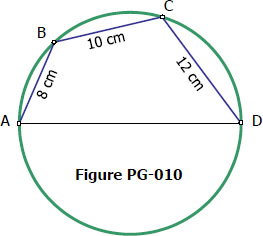Derivation / Proof of Ptolemy's Theorem for Cyclic Quadrilateral
Ptolemy's theorem for cyclic quadrilateral states that the product of the diagonals is equal to the sum of the products of opposite sides. From the figure below, Ptolemy's theorem can be written as
$d_1 d_2 = ac + bd$
The Cyclic Quadrilateral
A quadrilateral is said to be cyclic if its vertices all lie on a circle. In cyclic quadrilateral, the sum of two opposite angles is 180° (or π radian); in other words, the two opposite angles are supplementary.
$A + C = 180^\circ$
$B + D = 180^\circ$

- Read more about The Cyclic Quadrilateral
- Log in to post comments

